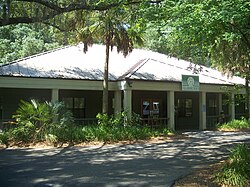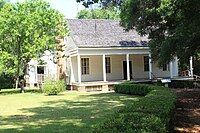History
Discussions in 1957 led to the formation of the "Tallahassee Junior Museum," a name which was eventually changed to "Tallahassee Museum," although the earlier name is still occasionally used. The museum was moved to its current 52-acre (210,000 m2) location in 1962, lodged between Lakes Bradford and Hiawatha, in Leon County, Florida.
Facilities and exhibits
A major strength of the museum lies in the diversity of its exhibits and the multiple utilization capabilities of its facilities.
Wildlife Florida
Another major portion of the museum is devoted to Florida wildlife, with many animals in relatively large, well-vegetated areas, usually similar to native habitats. Of note are black bears, white-tailed deer, and bobcats, as well as several endangered species: red wolves and Florida panthers. There are also several aviaries, a snake exhibit, small mammals, and a "guest" animal habitat, which was introduced in 1988.
Twice a day, there are "Animal Encounters," during which a staff member shows and teaches about an animal. They may show birds of prey, snakes, a rabbit, or a skunk. Many of the animals used for education have been injured, especially birds of prey. Since these animals could not survive in the wild, in accordance with state laws, they must either be used for education or be put down.
Florida & Beyond
This section includes the Fleischmann Natural Science Building with two freshwater aquaria and facilities for bird watching, the Phipps Gallery with changing exhibits of local art, culture and history, and the Discovery Center, a family interactive area with hands-on exhibits about the natural history and culture of North Florida.
Other
The museum also has several nature trails, one of which includes a boardwalk over normally flooded cypress habitat, and a number of special-use facilities for indoor exhibits and workspaces. In 2011, the museum became home to 23 of artist Jim Gary's Twentieth Century Dinosaur sculptures, with the sculptures being scattered across the grounds.
This page is based on this
Wikipedia article Text is available under the
CC BY-SA 4.0 license; additional terms may apply.
Images, videos and audio are available under their respective licenses.





